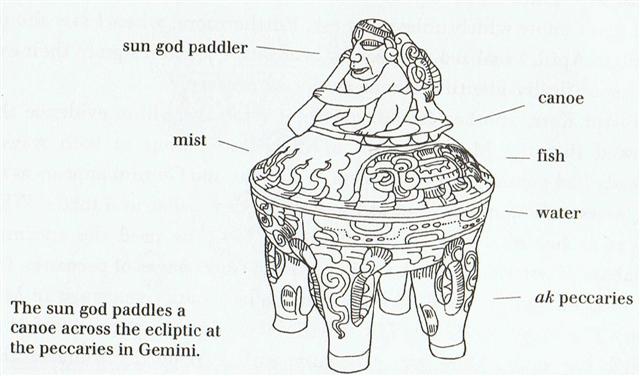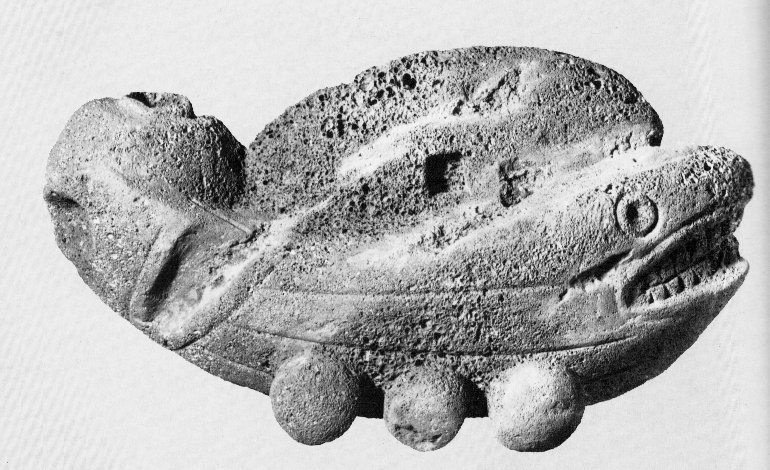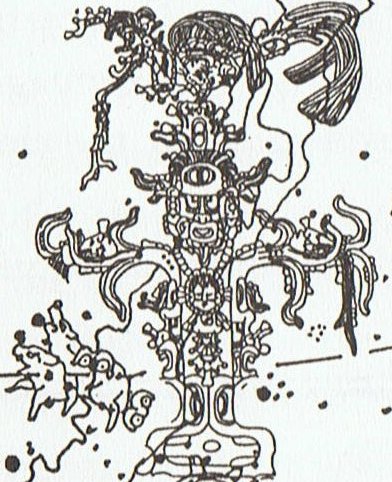|
TRANSLATIONS
The idea of the horizontal canoe gives me an opportunity to add important information from Maya Cosmos: "As I looked at the computer screen, everything clicked. Gemini had to be the copulating peccaries and Orion the turtle. The three stars on its back in the cartouche at Bonampak' were placed in the exact position of Orion's belt. But more important, the Maize God was reborn from the cracked carapace of a turtle, and we had a text that said that the first image of the turtle was seen at the Creation.  The two anthropomorphic figures between the peccaries and the turtle had to be the personifications of Saturn and Mars. And we already knew many examples of other planets, such as Venus and Jupiter, that were represented by anthropomorphic figures. We seemed to have two more here.
Not until much later did it hit me that August 6, the date of the zenith passage at Bonampak', was only seven days before the Creation day of August 13. Matt Looper provided the confirmation by calling my attention to a picture from the Madrid Codex, another of the four Maya books. It shows a turtle with a triangle of stones on its back.
The turtle in the codex is shown suspended from cords tying it to the skyband because Orion hangs below the ecliptic. Clearly Orion was the turtle from which the Maize God rose in his resurrection.
The Milky Way above the turtle had to be the Maize God appearing in his tree form as he does on the Tablet of the Foliated Cross at Palenque. The image of the first turtle really is in the sky. The identification of Gemini as copulating peccaries made sense in another curious way. For years we have seen pots that have these odd modeled peccary heads as their feet. All of these pots have the sea painted or drawn on their bottoms and an extraordinary one in the Dallas Museum of Arts shows the sun god paddling a canoe across this sea.
I realized that his must be the sun riding the ecliptic across the Peccaries of Gemini." (Maya Cosmos) I notice how the canoe of the sun god has the same double triplet of 'balls' at the bottom as we have seen in the 'sun boat' stone sculpture from Easter Island:
It is really a kind of fish, though. And the Mayan sun god has what for me looks like a fish sign on his back. If we look closer at the Maize God, we can see that the horizontal 'beam' has heads looking upwards at the ends:
Structurally regarded, the horizontal 'beam' therefore is similar to a Polynesian canoe, with rei mua and rei muri at the ends. We can also connect the horizontal 'beam' with Rei:
The signs of 'moon' (which cannot be found on the rei miro sculptures) agree in position and general form with the foliage hanging down from the 'beam'. Though the orientation is the opposite, perhaps due to the location of Easter Island south of the equator. A rather modern western ship on a petroglyph drawing (from Easter Island), which has puzzled me, may now be more easily understood: Of course such a great ship must be the sun ship and therefore have a turtle connected below:
(Heyerdahl) The curious sign at the copulating peccaries (Gemini) reminds me about an earlier picture with Venus symbolized by the sign:
The sun god lying on 'the earth' may very well depict him lying on the ecliptic. From which follows the suggestion that the two heads, one in front and one at the back - at the ends of the horizontal 'beam' (across the 'tree' of the Maize God) - presumably also depict the sun god. The two heads on rei miro canoes could be the sun god. Possibly the two Venus signs at the copulating peccaries show how the planet sometimes is above and sometimes below the ecliptic. The two 'eyes' probably mean morning respectively evening 'star'. |








